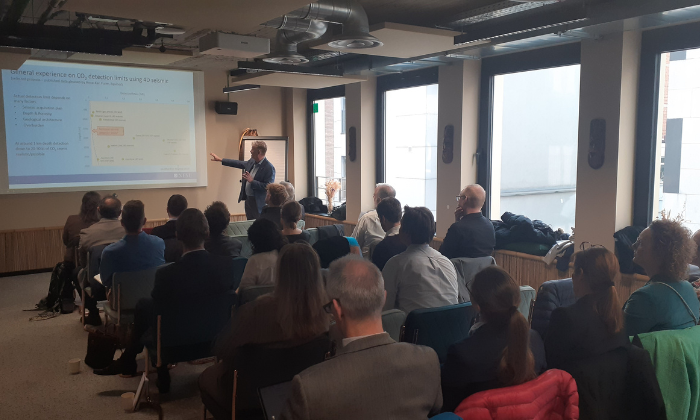CO₂ storage monitoring: technologies and lessons learned
CO₂ storage monitoring was the focus of a workshop hosted on 31 January 2025 in Brussels. Hosted by the Zero Emissions Platform (ZEP) and the European Commission, it convened 140+ experts from industry, research, and over 20 public authorities to share practical guidance on CO₂ storage monitoring, permitting, and operations. The goal: help competent authorities scale safe, effective CO₂ storage to support the Net Zero Industry Act (NZIA) target of at least 50 Mt/year of injection capacity by 2030. This article summarises the key points from this event.
About the workshop
As Europe accelerates industrial decarbonisation with the NZIA, geological CO₂ storage is a cornerstone solution. Under this regulation, the EU must ensure the availability of at least 50 million tons of CO₂ injection capacity per year by 2030.
Opening remarks by Eadbhard Pernot (ZEP) and Daniel Kitscha (European Commission) emphasised the urgent need to scale up CO₂ storage, while maintaining public trust, transparency, and regulatory excellence.
The workshop focused on sharing real-world insights into monitoring strategies, permitting processes, and operational best practices to support competent authorities across Europe in implementing safe and effective CO₂ storage systems. It convened 140+ participants from industry and research, as well as more than 20 governmental authorities, to:
- Provide insights into the development, permitting, and monitoring of commercial operating CO2 storage sites;
- Outlining the key components and design of monitoring plans;
- Sharing knowledge and experiences with the European competent authorities;
- Connecting independent observers and regulators with counterparts globally.
Session 1 – An overview of CO₂ storage monitoring plans and technologies
Developing monitoring plans
During this presentation, Tim Dixon and Nicole Clarke (IEAGHG) gave an overview of environmental and accounting aspects of CO₂ storage monitoring, aligned with IPCC inventory guidelines and global regulatory goals. They emphasised:
- The need to ensure monitoring is site-specific, risk-mitigating, and aligned with the EU Carbon Capture and Storage (CCS) Directive and IPCC guidelines,
- The showcase of the IEAGHG Monitoring Selection Tool, a web-enabled decision tool built in 2005 and maintained by the British Geological Survey (BGS) every ~3 years, hosting catalogs of 40 techniques across 26 case studies,
- The accumulated years of experience from 41 large-scale CO₂ storage projects operating since the 1970s, including deep saline formation storage since 1996 at sites such as Sleipner, Boundary Dam, and Quest.
IEAGHG’s blog post on the workshop is available here.
Onshore monitoring
Katherine Romanak (UT Austin Gulf Coast Carbon Center), shared insights drawn from the extensive experience with pilot, demonstration, and industrial onshore CO₂ storage projects in the U.S.. These projects are primarily funded through the US DOE’s Regional Carbon Sequestration and CarbonSAFE programs. The presentation highlighted:
- The need for robust baseline scenarios and the use of accurate attribution techniques (e.g., process-based soil gas ratios) to accurately distinguish between natural anomalies and actual CO₂ leakage in the shallow subsurface.
- The importance of having clear protocols for responding to stakeholder concerns. This includes developing fast, accurate, and accessible communication methods with clearly defined thresholds (with examples from Tomakomai and Weyburn).
Offshore monitoring
Philip Ringrose (NTNU) presented & an outline of offshore monitoring technologies, grounding both the rationale and practical approaches of monitoring. He emphasised that next-generation monitoring can be both high-tech and cost-effective by using fiber-optic technologies and by targeting monitoring efforts at the right time and in the right place.
The session particularly focused on:
- The importance of monitoring seabed seismicity as CO₂ storage scales in the North Sea. Although studies show a low risk of induced earthquakes, it would prevent false associations with tectonic activity and support public and regulatory trust.
- Overcoming imaging challenges in deeper formations with 4D seismic imaging, fiber-optic sensing, and full-waveform inversion (FWI), to improve seismic resolution and storage quantification.
Session 2 – Permitting and licenses: developing effective monitoring plans
During this session, experts from the U.S. and the UK – Randy Locke (Illinois State Geological Survey), Mohammad Khadhrawi (Illinois State Geological Survey), Kevin Connors (EERC), Lily Barkau (Wyoming state regulator), Ian Barron (North Sea Transition Authority) – shared their experience on permitting in practice.
They illustrated varied regulatory approaches to CO₂ storage permitting. They also emphasised the need for clear, flexible permitting to reduce uncertainty for applicants to be able to achieve CO2 targets, particularly focusing on:
- The experiences from the Illinois Basin Decatur Project (IBDP) (which has stored ~4.8 million tonnes), North Dakota, and Wyoming. They showed diverse regulatory models under federal and state level permitting, as well as the procedure for the US EPA Class VI permits, and the permit tracker with the current status of 161 well applications and 56 projects under review.
- The importance of addressing key areas of uncertainty for applicants by providing clear permitting criteria while allowing flexibility for site-specific considerations. This includes: clarifying expectations around the time and effort required for application development, technical evaluations, regulatory review timelines, and procedures for post-permit changes such as project modifications and site closure requirements.
Session 3 – Operating storage sites: handling monitoring data
Philip Ringrose (NTNU), Randy Locke & Mohammad Khadhrawi (Illinois State Geologic Survey), Katherine Romanak (UT Austin Gulf Coast Carbon Center), and John Hamling (EERC) presented on monitoring and verification lessons from the following projects: Sleipner, Snøhvit, In Salah, Illinois Industrial, SACROC, Petra Nova, Red Trail, Blue Flint, and Great Plains Synfuels.
They covered required monitoring data, methods of data collection and interpretation, and response planning, specifically addressing:
- The value of simpler well designs, as well as the importance of the deep monitoring wells to yield high-value datasets for characterisation and monitoring activities.
- Case studies from North Dakota showcase how MMV plans, compliance strategies, and advanced monitoring tools can support data-driven design and reduce uncertainty in CO₂ storage operations.
- The importance of early operational planning and baseline data collection.
Conclusions and next steps
The workshop demonstrated a strong commitment to supporting European regulators in achieving the NZIA’s goals by bridging the knowledge gap between operational projects and regulatory frameworks to lay the foundation for safe and scalable CO₂ storage in Europe.
The workshop concluded with the following recommendations:
- Open-source platforms need to be fostered (e.g., IEAGHG Monitoring Tool) due to their important role in facilitating global knowledge sharing.
- Transparent permitting procedures with ongoing stakeholder dialogue throughout the project lifecycle are essential and must be supported.
- EU authorities should be encouraged to build on the international experience to guide the next generation of CO₂ storage development.

